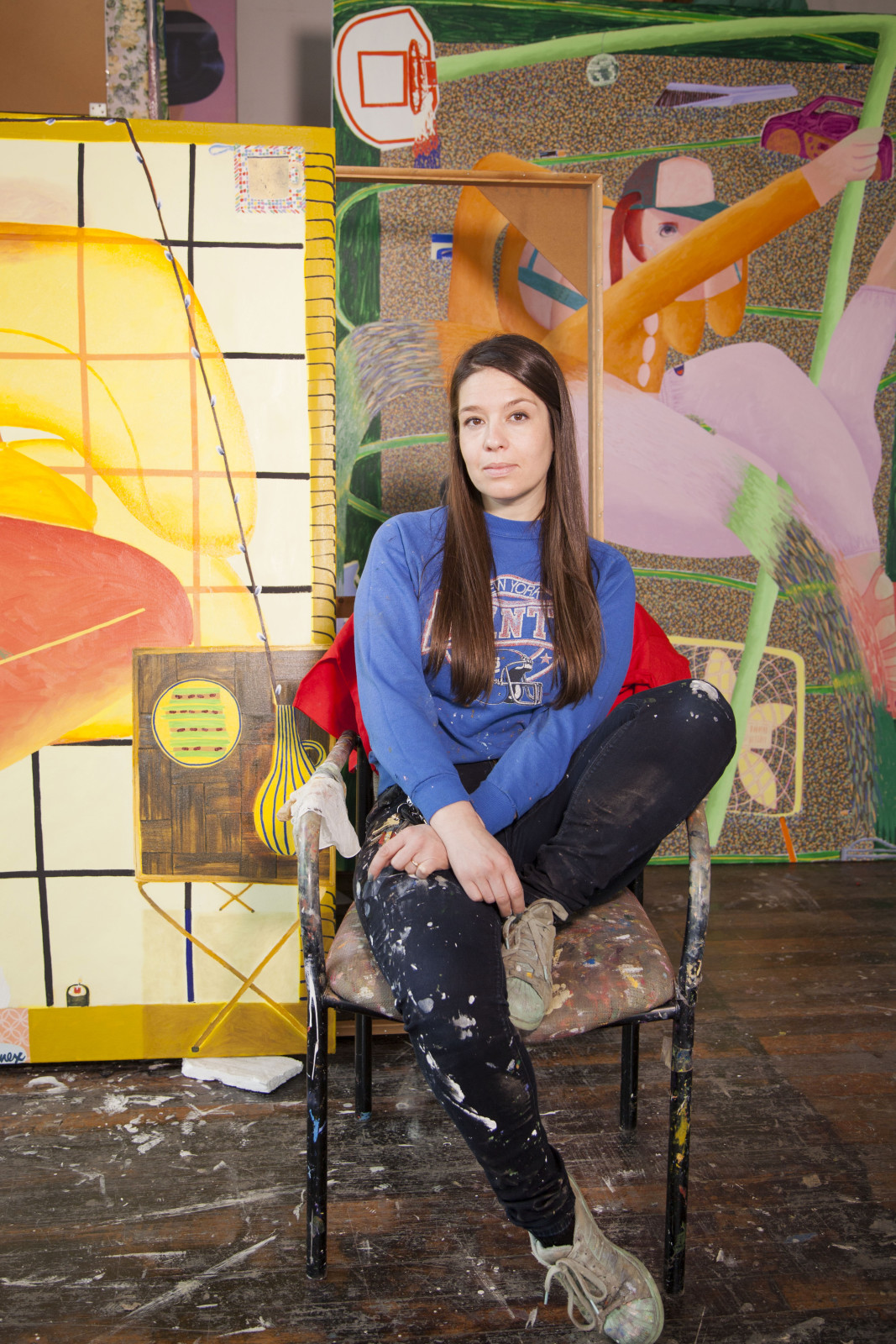
Chicago-based artist Celeste Rapone (b. 1985) has a body of work most recognized for its distinct balance of figuration and abstraction, as well as unique—and often enigmatic—use of narrative. Employing formal elements such as color, shape, and finish as tools to both heighten a sense of atmosphere as well as structure her compositions, the metaphorical and illustrative aspects ultimately meld to create a cohesive whole. Mining her personal life history as well as tapping art history, Rapone’s paintings read simultaneously as both foreign and familiar—evoking feelings akin to nostalgia or déjà vu, and giving the sense that the viewer has been granted a deeply private glimpse into a vignette of someone else’s everyday life.
Currently, the artist’s newest body of work is on view at Josh Lilley, London, in the solo exhibition “Celeste Rapone: House Sounds.” Featuring the artist’s signature artistic lexicon, Rapone interrogates the myriad facets that comprise “home,” both on a personal level as well as from an abstract, overarching perspective.
We recently caught up with Rapone to learn more about her second exhibition with the gallery, and what home means to her.
Celeste Rapone, Contenders (2023). Courtesy of Josh Lilley, London.
Can you tell us a bit about the works in your solo show “House Sounds” and the inspirations behind the exhibition?
The paintings in this show are really about navigating a relationship with home. They were made while my husband and I moved into our first house, and I found myself negotiating pretty intense insecurities about the future, starting a family, and establishing permanence in a place far from where I’m originally from. To me, the phrase “House Sounds” embodies all the noise that can be found in (or absent from) houses—the beautiful, strange, funny, loud, silent, crude, etc.—which I’m hoping the paintings tap into.
The concept of “home” is a core underlying theme of the show. What does “home” mean to you on a personal level?
For me, it’s a place that reflects who I am and where I can be the most myself. And that can be a lot! It’s how I would describe both my house and studio.
Celeste Rapone, Blue Basement (2023). Courtesy of Josh Lilley, London.
Across the works in the show there is an element of object specificity; for instance, not just a water bottle but a reusable Klean Kanteen stainless steel bottle, not just wine but Yellow Tail Shiraz. Could these be interpreted as symbols, or perhaps clues to a larger narrative?
A lot of the objects in these canvases are pulled directly from my life. My paintings really are a collision of my upbringing in North Jersey, specific nods to art history, and daily life in Chicago. I think of the objects as relics or pieces of memorabilia that contribute to the autobiographical nature of the work. I use a Klean Kanteen nowadays in the studio and large format Yellow Tail Shiraz was a regular fixture in my house growing up. There’s a lot of clothing and accessories present from my teen years, as well as paint samples that we used to pick our basement color, and a light fixture we recently installed in our dining room. In general, I think a lot of my female figures are struggling with aging, boredom, and uncertainty; I’m interested in how merging those chronologies on the canvas can sort of collapse time.
What do you hope your work evokes or inspires in visitors to the exhibition?
I mostly just hope they enjoy the experience of looking at the work. Maybe something could provoke a reaction, whether a chuckle or a smirk or identification with larger themes of doubt and unmet expectation. But honestly, that would just be a bonus.
Celeste Rapone, Weekenders (2023). Courtesy of Josh Lilley, London.
How would you describe your compositional process, is it more intuitive or is everything carefully planned out?
Everything is intuitive these days, I’m not really one to start with preliminary drawings. I’ll usually begin with a color or narrative in mind and just go for it. Day one on a painting is sussing that out, and then it takes its own journey until it’s finished. With this show in particular, color and composition both shifted for me. Now I can admit I’m a bit obsessive about color, think Delia in Beetlejuice. At our new house we inherited a color palette that didn’t reflect our taste. I wanted to mimic that cringe in the studio and so began a lot of paintings with color combinations that I don’t normally use or like. That became a great problem to start with and work through. Similarly with composition, in some of these pieces I developed the spaces first and then introduced the figure into essentially already fully realized compositions—I was curious about how that could amplify the feeling of the figure not comfortably fitting into the frame.
Can you tell us about what you are working on now, or would like to work on next?
I’ve got a few things going in the studio for some upcoming fairs. It’s really nice to jump into new pieces right after finishing a show. There’s a level of permission you give yourself to just try anything, play a bit, and hopefully learn something before hunkering down on the next larger body of work.
Celeste Rapone, Drawing Center (2023). Courtesy of Josh Lilley, London.
In the past, you’ve engaged with ideas around life’s many paths and possibilities. If you weren’t a painter, what would you be?
I’d be lost (laughs)! But in reality, probably something with fashion or food—as a kid I always wanted to be a costume designer.
“Celeste Rapone: House Sounds” is on view at Josh Lilley, London, through April 29, 2023.